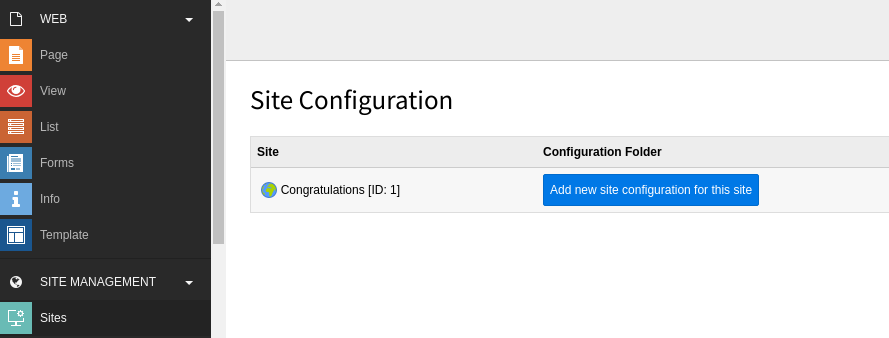Attention
TYPO3 v10 has reached end-of-life as of April 30th 2023 and is no longer being maintained. Use the version switcher on the top left of this page to select documentation for a supported version of TYPO3.
Need more time before upgrading? You can purchase Extended Long Term Support (ELTS) for TYPO3 v10 here: TYPO3 ELTS.
For Integrators¶
Tip
Read TYPO3 CMS Certified Integrator to learn what the TYPO3 Association defines as integrator.
If you want to learn how to professionally setup or maintain TYPO3 websites, you can look at the following resources:
Site and Language Handling¶
You can:
setup several websites in one TYPO3 installation
setup several languages for each site
Before TYPO3 9, it was necessary to setup the language configuration for each site manually with TypoScript.
TYPO3 9 comes with a powerful site handling module which is document in Site Handling. This includes, setting up sites, language configuration and URL handling. Find out more about URL handling in the next section.
Even if you only use one language or only one site, it is recommended to setup the site configuration. You can find it in the backend under SITE MANAGEMENT: Sites.

Human-readable URLs¶
By default TYPO3 CMS identifies the page which should be delivered by the "?id"
parameter. Just enter https://example.org/index.php?id=33 to get
the "Overview" page of the Introduction Package.
This is convenient but not good for visitors nor for proper referencing.
Starting with version 9.5, human-readable URLs are created automatically by TYPO3. This functionality is available for pages, languages and also extensions. The documentation is available in "TYPO3 Explained" Site Handling.
Other tutorials like TYPO3 Worx: TYPO3 Site Management and Routing and TYPO3 Worx: TYPO3 Routing: Extensions and Enhancers are also available.
For previous TYPO3 versions, this functionality was provided by third party extensions like realurl.
Thus, the URL as mentioned earlier becomes for example
https://example.org/content-examples/overview/.
Create Your Own Sitepackage (Theme)¶
In this tutorial, you used the Introduction Package which depends on and uses the Bootstrap Package extension.
The Introduction Package is a distribution. Find out more about distributions in "TYPO3 Explained": Creating a new distribution.
The Introduction Package together with the Bootstrap Package provides a frontend layout based on bootstrap, adds configuration and creates some initial pages and content. While this is useful for quickly setting up a full-blown TYPO3 website, you will probably want to create a custom theme for your own site.
A good approach is to bundle everything for your site including a theme and configuration into a sitepackage.
Read the TYPO3 Sitepackage Tutorial to learn how to do this.
Or watch this 3 part video series from the official TYPO3 YouTube channel:
TypoScript¶
While the already mentioned TYPO3 Sitepackage Tutorial teaches you the TypoScript you need to create a sitepackage, it is not a bad idea to get yourself a TypoScript introduction.
TypoScript in 45 Minutes guides you through the basics of TypoScript.
Use the TypoScript Reference as a reference.
Fluid¶
In the TYPO3 Sitepackage Tutorial you will also have acquired a working knowledge of Fluid, the templating engine. To learn more about Fluid, you may want to use the following resources:
Fluid documentation: As Fluid itself can be used independently to TYPO3, it is developed outside of the TYPO3 project. This is the start page of the Fluid project.
Styling the output with Fluid in the "Extbase / Fluid Book"
